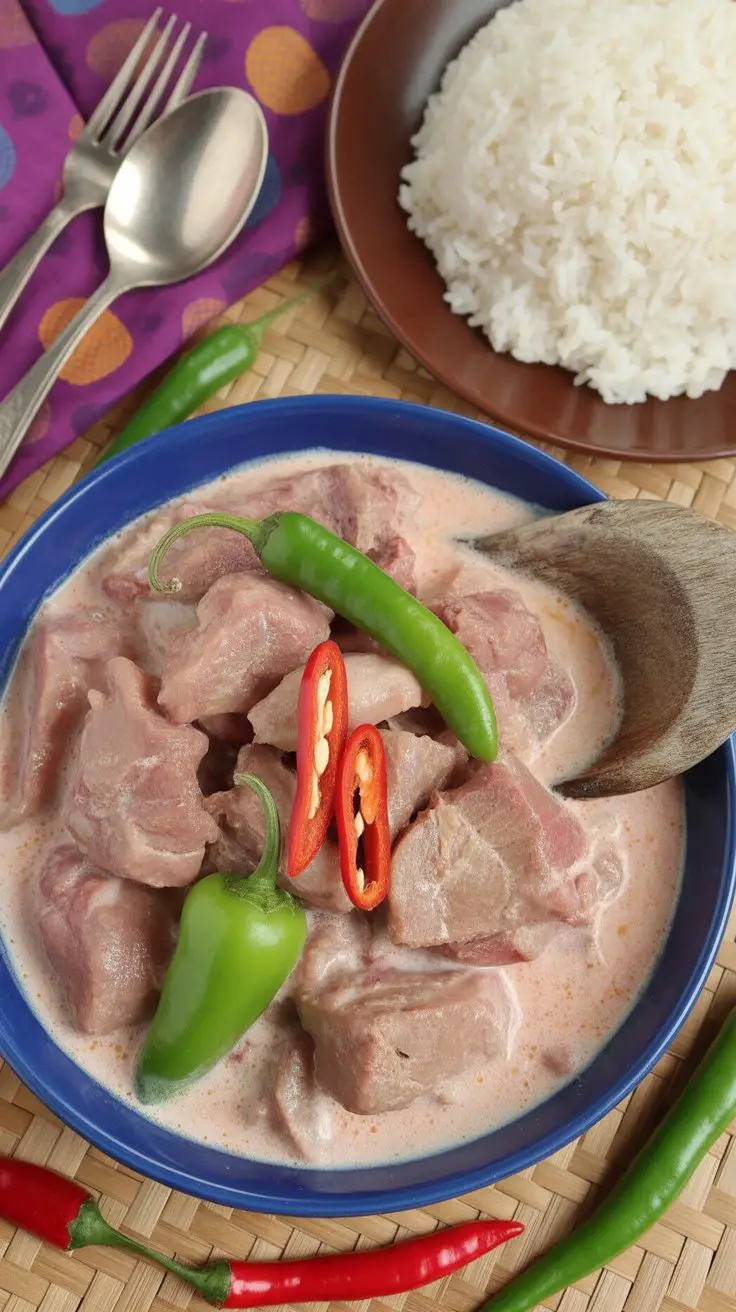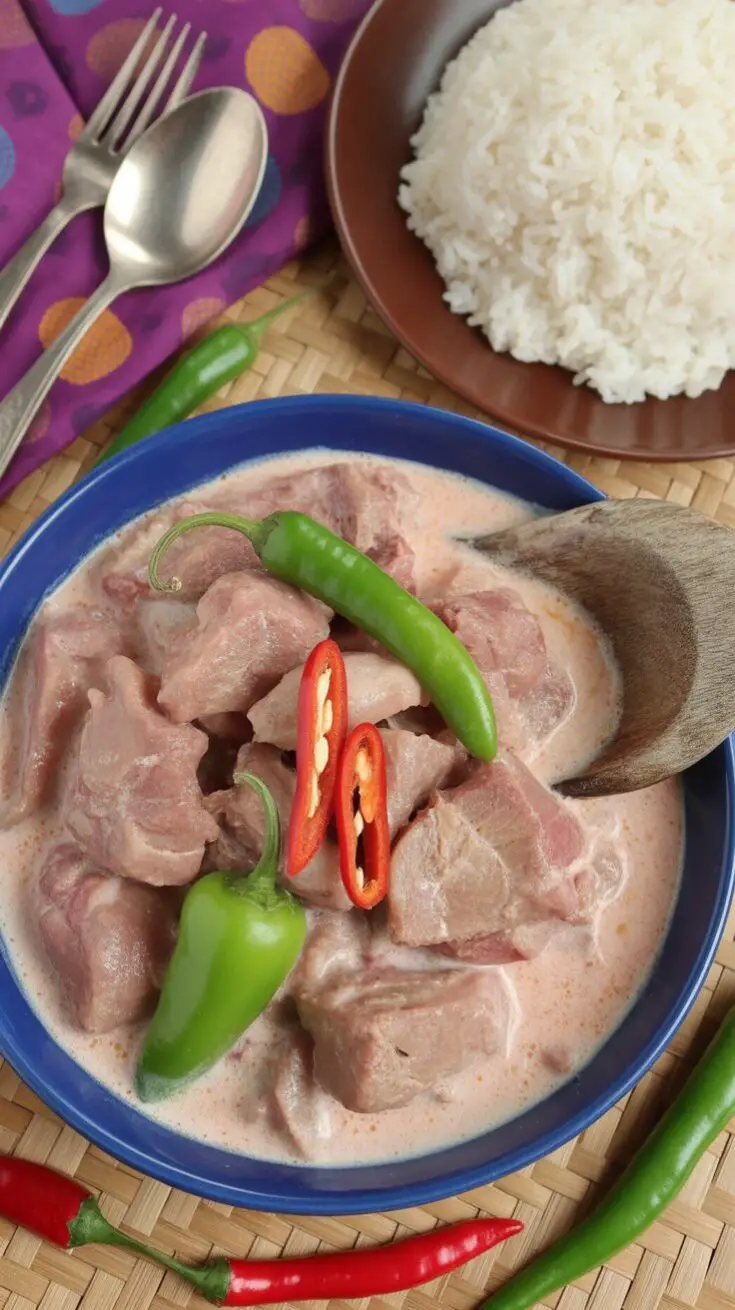If there’s one dish that truly lives up to its name, it’s Bicol Express. The heat hits you fast, the creaminess keeps you hooked, and before you know it, you’ve polished off more rice than you planned. This pork cooked in coconut milk and chili peppers is bold, rich, and unforgettable. It’s not the kind of dish you whisper about—it announces itself at the table, and everyone leans in.
 I first learned to love Bicol Express because of a coworker from Bicol. I once brought her a portion of my gising-gising, proud as ever, hoping she’d praise it. She politely ate a bite, smiled, and the next day walked in with a Tupperware of her own cooking. She said, “This is how you do spicy. Go big or go home.” I still remember that first mouthful—it set my tongue on fire, but it was so good I kept going back for more. That’s when I realized Bicol Express isn’t just a recipe, it’s an attitude.
I first learned to love Bicol Express because of a coworker from Bicol. I once brought her a portion of my gising-gising, proud as ever, hoping she’d praise it. She politely ate a bite, smiled, and the next day walked in with a Tupperware of her own cooking. She said, “This is how you do spicy. Go big or go home.” I still remember that first mouthful—it set my tongue on fire, but it was so good I kept going back for more. That’s when I realized Bicol Express isn’t just a recipe, it’s an attitude.
Ingredients That Matter
For me, the heart of Bicol Express is the holy trio of pork belly, coconut milk, and chilies.
Pork belly – I usually stick to pork belly because the fat melts into the sauce and makes it luscious. If I’m cooking for folks watching their waistline, I swap it for pork shoulder. It’s leaner but still flavorful.
Coconut milk – Fresh coconut milk has a sweetness that canned versions can’t quite match, but I mostly cook with canned since it’s practical. If you can, choose one without stabilizers for a cleaner, smoother sauce.
Shrimp paste (bagoong) – I learned the hard way that not all shrimp paste is the same. If you’re abroad and only have access to that neon pink bottled kind, rinse it first. It tones down the saltiness and prevents the sauce from picking up that artificial tint.
Chilies – This is where you make it your own. I throw in Thai chilies for fiery heat and finger chilies for body. If I’m serving my parents, I scrape out some seeds so it’s more forgiving. But if I’m cooking for my Bicolano friends, I don’t dare hold back.
Sometimes, I toss in long beans or winged beans if I want more vegetables in the dish. The beans soak up the sauce beautifully.
 How I Cook It
How I Cook It
Cooking Bicol Express isn’t complicated, but it does reward patience. Here’s how I usually go about it:
I start by browning the pork slowly. It renders out some fat and builds flavor.
In goes the garlic, onion, and ginger—I let them soften until they smell sweet.
A spoonful of shrimp paste follows, and I give it a minute to toast. That smell is enough to make everyone in the house peek into the kitchen.
Then the coconut milk goes in, and this is where I keep the heat gentle. Too high and it splits; steady simmering gives you that silky sauce.
Once the pork has softened, I add the chilies and coconut cream. The cream thickens the sauce and gives it that luxurious finish.
Tip: If you want neat slices of pork belly, pop it in the freezer for about 30 minutes before cutting—it firms up and makes your knife glide.
My Best Kitchen Tips
Don’t rush the simmer. The longer the pork sits in coconut milk, the more it soaks up the flavor.
If you’re scared of too much heat, use the chilies whole at first and taste as you go. You can always slice them later if you want more punch.
I sometimes add a little sugar if the shrimp paste is very salty—it balances the whole dish without making it sweet.
 Everyday Questions
Everyday Questions
What’s the difference between laing and Bicol Express?
Laing uses dried taro leaves simmered in coconut milk, while Bicol Express is pork-based and saucy. Both are rich, but laing has an earthy undertone from the leaves.
Can I use coconut cream instead of coconut milk?
Coconut cream is thicker and richer. I like using a mix—milk for simmering, cream for finishing. If you use only cream, you may need to thin it slightly with water.
How I Serve It
This is not a “small scoop” kind of dish. I serve it in a big bowl at the center of the table, surrounded by steaming hot rice. A spoonful of Bicol Express on top of plain rice is perfect balance—the rice calms the heat, the pork and sauce keep you coming back for another spoonful. Sometimes, I even pair it with grilled fish or fried eggplant on the side.
Storing Leftovers
Because it’s made with coconut milk, it doesn’t last very long on the counter. I let it cool, then tuck it into a sealed container in the fridge—it stays good for up to 3 days. If I know I won’t finish it, I freeze portions for up to 2 months. The sauce might separate after thawing, but a gentle stir over low heat brings it back together.
Bicol Express

Rich coconut milk, tender pork belly, and fiery chilies come together in this creamy, comforting classic. Bicol Express is a bold, spicy dish that’s best enjoyed with plenty of steamed rice to soak up every drop of its luscious sauce.
Ingredients
- 2 pounds pork belly, cut into 1-inch cubes
- 1 can (13.5 ounces) coconut milk
- 1 cup coconut cream
- 1 cup water
- 1 tablespoon oil
- 1 onion, thinly sliced
- 4 cloves garlic, minced
- 2 tablespoons fresh shrimp paste
- 14 Thai chili peppers, stemmed and minced
- 2 cups finger chilies (siling haba), sliced
- Salt and pepper, to taste
Instructions
- Warm the oil in a wide pan over medium heat. Sauté the onion and garlic until softened and fragrant.
- Add the pork belly and cook until lightly browned, letting the edges render a bit of fat.
- Stir in the shrimp paste and cook briefly to deepen the flavor.
- Pour in the coconut milk and water, followed by the minced Thai chilies. Bring everything to a gentle simmer and cook until the pork is tender and the sauce reduces, about 35 minutes.
- Toss in the finger chilies and cook for a couple of minutes to soften them slightly.
- Finish by stirring in the coconut cream and let the dish simmer until thick, rich, and beginning to release oil. Season with salt and pepper to taste.
- Serve hot with steamed rice and enjoy the comforting heat of this Filipino favorite.
Final Thought
Bicol Express isn’t just about spice—it’s about comfort, culture, and a little bit of challenge. Every time I cook it, I’m reminded of that Tupperware from my coworker that taught me to stop being timid with chilies. If you’ve never tried making it at home, don’t hold back. Cook it, share it, and yes—get that extra scoop of rice ready.
Try other Filipino recipes:

 How I Cook It
How I Cook It Everyday Questions
Everyday Questions
















